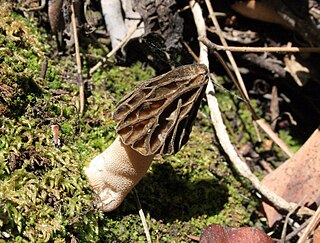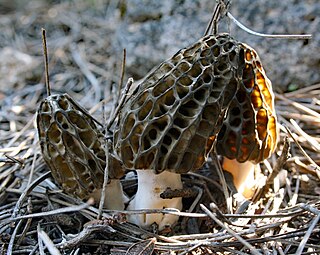
Morchella, the true morels, is a genus of edible sac fungi closely related to anatomically simpler cup fungi in the order Pezizales. These distinctive fungi have a honeycomb appearance due to the network of ridges with pits composing their caps. Morels are prized by gourmet cooks, particularly in Catalan and French cuisine, but can be toxic if consumed raw. Due to difficulties in cultivation, commercial harvesting of wild morels has become a multimillion-dollar industry in the temperate Northern Hemisphere, in particular North America, Turkey, China, the Himalayas, India, and Pakistan where these highly prized fungi are found in abundance.

Morchella elata is a species of fungus in the family Morchellaceae. It is one of many related species commonly known as black morels, and until 2012 the name M. elata was broadly applied to black morels throughout the globe. Like most members of the genus, M. elata is a popular edible fungus and is sought by many mushroom hunters.

Morchella conica is an old binomial name previously applied to species of fungi in the family Morchellaceae. It is one of three scientific names that had been commonly used to describe black morels, the others being M. angusticeps and M. elata. It was first introduced by mycologist Christian Hendrik Persoon in 1818, as a superfluous name for the old taxon Morchella continua. According to Richard and colleagues, Fries’ sanctioning applies only at the subgeneric level and the name is illegitimate.

Morchella rufobrunnea, commonly known as the blushing morel, is a species of ascomycete fungus in the family Morchellaceae. A choice edible species, the fungus was described as new to science in 1998 by mycologists Gastón Guzmán and Fidel Tapia from collections made in Veracruz, Mexico. Its distribution was later revealed to be far more widespread after several DNA studies suggested that it is also present in the West Coast of the United States, Israel, Australia, Cyprus, Malta and Switzerland.

Morchella tridentina is a cosmopolitan species of ascomycete fungus in the family Morchellaceae. Commonly referred to as the mountain blond or western blond morel in North America, it produces conical, grey to buff fruit bodies that are rufescent and grow up to 20 cm (7.9 in) tall and 5 cm (2.0 in) wide. This early-diverging species is distinct within the /Elata clade due to its pale colours and has been described by many names in the past, including M. frustrata, M. quercus-ilicis, M. elatoides, M. elatoides var. elegans and M. conica var. pseudoeximia, all of which were shown to be synonyms. A widely distributed relict of the last Ice Age, M. tridentina is so far known from Argentina, Armenia, Chile, Cyprus, France, India, Israel, North America, Spain and Turkey.

Morchella americana is a North American species of fungus in the family Morchellaceae.
Morchella capitata is a later synonym of Morchella exuberans. Originally identified as phylogenetic species Mel-9, it was described as new to science in 2012 by Kuo and colleagues. In 2014 however, Richard and colleagues clarified the taxonomic status of this species, retaining the name Morchella exuberans of Clowez (2012) over M. capitata.

Morchella anatolica is a rare species of ascomycete fungus in the family Morchellaceae. It was described as new to science in 2010 from southwest Anatolia, Turkey, where it grows on moss-covered stream beds in pine forests. An ancient climatic relict, M. anatolica is restricted to the Mediterranean basin and has also been documented in Spain, Cyprus and Greece, where it is sometimes encountered with trees of the Oleaceae family. Together with its sister-species Morchella rufobrunnea, they are the earliest diverging lineages in genus Morchella, forming a distinct clade that is basal in global morel phylogenies. Because of its phylogenetic position, M. anatolica has been crucial in inferring the historical biogeography of the genus, which is estimated to have emerged somewhere in the Mediterranean region in the late Jurassic.

Morchella arbutiphila is a species of fungus in the family Morchellaceae (Ascomycota), described from the island of Cyprus in 2016. The species is notable for its elongated stipe, which is often longer than the cap's length, its ascospores which are larger than most other species of Morchella, and its highly specific ecological preferences. It is known only from igneous substrates of the Troodos mountains in Cyprus and from a single collection in the Aegean region of Turkey.

Morchella disparilis is an Ascomycete fungus in the family Morchellaceae. Described as new to science in 2016, M. disparilis appears to be confined to the Mediterranean basin and is so far known from Cyprus, Greece and Spain. Its most striking feature is the exceptionally deep sinus, intermediate in depth between half-free morels of the Morchella semilibera clade and typical Distantes species.

Morchella fluvialis is a species of fungus in the family Morchellaceae. It was described as new to science in 2014 by Clowez and colleagues, following collections from riparian forests in Spain under Alnus glutinosa, Ulmus minor and Eucalyptus camaldulensis, although previous collections from Turkey under Pinus nigra have also been reported. This species, which corresponds to phylogenetic lineage Mes-18, is very close to Morchella esculenta, from which it differs in its elongated cap with oblong pits and predominantly longitudinal ridges, pronounced rufescence, as well as its Mediterranean hygrophilic distribution along rivers and streams.
Morchella palazonii is a species of morel found in Spain.

Morchella eximia is a globally-occurring fungus in the family Morchellaceae (Ascomycota), first described by Émile Boudier in 1910. In an elaborate phylogenetic and nomenclatural revision of the genus in 2014, Richard and colleagues showed that the taxa Morchella anthracophila, Morchella carbonaria, and Morchella septimelata, proposed in 2012 by Clowez and Kuo et al. respectively, are all later synonyms of this old taxon.

Morchella dunensis, the morel of the dunes, is a species of fungus in the family Morchellaceae (Ascomycota). It was first described as a form of Morchella esculenta by Castañera and colleagues in 1996, but was later recombined as a distinct species by Clowez. In a 2014 study by Richard and colleagues, the authors concluded that the taxon was conspecific to Morchella vulgaris, due to its close phylogenetic proximity to the latter. However, following increased molecular sampling and the testing of an isoparatype collection by Loizides and colleagues in 2016, it was revealed that M. dunensis is indeed very closely related to, but phylogenetically distinct from M. vulgaris. This study also showed that the taxon Morchella andalusiae is phylogenetically identical and therefore a later synonym of M. dunensis.

Morchella dunalii is a species of fungus in the family Morchellaceae (Ascomycota). A widespread species in the Mediterranean basin, M. dunalii is so far known from the Balearic islands, the islands of Corsica and Cyprus, France, Spain and Turkey, where it appears to be abundant. It fruits very early in the season on calcareous soil, usually in association with the Aleppo pine, Calabrian pine and holm oak.

Morchella vulgaris is a widespread fungus of the family Morchellaceae (Ascomycota). It was originally described in 1801 as a form of the common yellow morel by mycologist Christiaan Hendrik Persoon, but was later recombined as a distinct species by Samuel Gray.

Morchella purpurascens, the purple morel, is an ascomycete fungus in the family Morchellaceae. It was first described as a variety of Morchella elata by Emile Boudier in 1897, based on a plate previously illustrated by Julius Vincenz von Krombholz. It was then recombined as a distinct species in 1985 by Emile Jacquetant, and validated the following year by Jacquetant and Bon. As with many other morel species, its taxonomical status remained for a long time a subject of debate, until an extensive phylogenetic and nomenclatural study in 2014 by Richard and colleagues confirmed this species' autonomy and matched it to phylogenetic lineage Mel-20.
Morchella exuberans is a species of fungus in the family Morchellaceae (Ascomycota). It was described as new to science in a 2012 study by Clowez and corresponds to phylogenetic lineage Mel-9. Morchella capitata, described by Kuo and colleagues later in the same year, is a synonym of this taxon.
Morchella casteneae is a species of fungus in the family Morchellaceae (Ascomycota). It was described as new to science in a 2012 study by Clowez and appears to be confined to the Iberian peninsula. A subsequent phylogenetic and nomenclatural study by Richard and colleagues has confirmed M. castaneae as a distinct species and showed the taxa Morchella brunneorosea and Morchella brunneorosea var. sordida to be synonymous.

Morchella sceptriformis is a species of fungus in the family Morchellaceae (Ascomycota). It was described as new to science in a 2012 study by Clowez, and corresponds to phylogenetic lineage Mes-3. Morchella virginiana, described later in the same year by Kuo and colleagues, is conspecific to this taxon.














